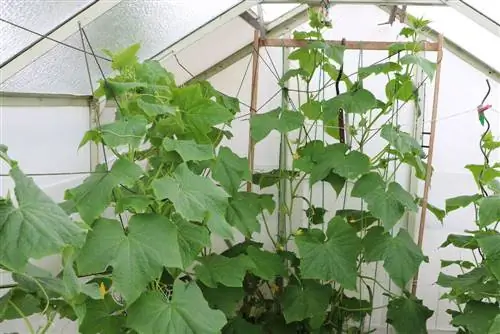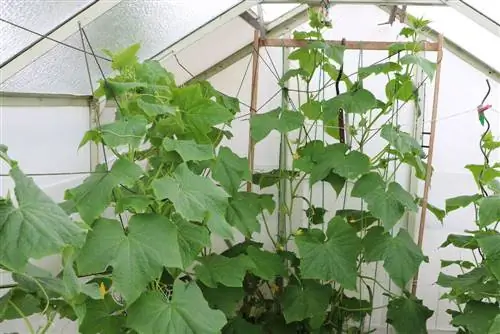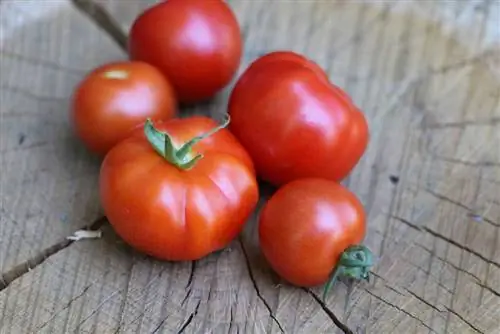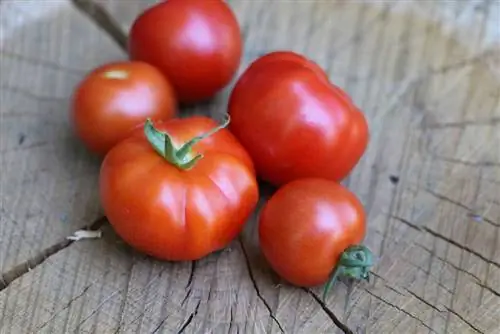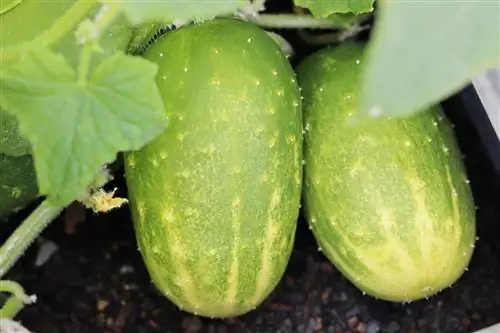- Author admin [email protected].
- Public 2023-12-17 03:39.
- Last modified 2025-01-24 12:45.
Cucumbers, botanically called Cucumis sativus, belong to the cucurbit family (Cucurbitaceae). Actually, their fruits should be called berries because their seeds are embedded directly in the pulp. Cucumbers originally come from India and have been cultivated there for over 3,000 years. They came to Europe in the 19th century and have been cultivated in our greenhouses ever since.
Sowing
From around mid-March, the seeds of snake cucumbers can be sown in the heated greenhouse. Cucumbers that are intended for outdoor cultivation can be grown on the windowsill or in the cold frame. However, sowing should not take place before mid-April so that the young plants do not become too large before they are planted in the bed.
- Fill cultivation pots only halfway with substrate
- place two to three seeds each
- cover with about 1 cm of soil
- Substrate: potting soil
- Minimum temperature: 20 degrees
- keep evenly moist
- set up brightly
- protect from the midday sun
- Germination time: 3 to 4 days
Let all the seedlings grow until the leaves of the strongest plant are poking over the edge of the pot. All weaker plants are removed. Then fill the cultivation pot with humus-rich, well-drained soil. In this way, the cucumber plant forms additional roots (adventitious roots) at the bottom of the stem. These ensure a better water and nutrient supply and more stability.
Pre-grown plants
In addition to seeds, refined cucumber plants are also available in specialist stores. Pumpkin seedlings serve as a rootstock. The advantage lies in the plant's strongly developed root system and its resistance to fungal diseases. The base provides the cucumbers with nutrients and water particularly reliably.
Location
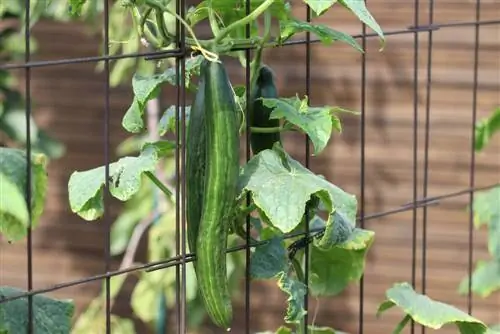
Cucumbers love a location that is as warm as possible with lots of sun. The optimal temperatures are between 20 and 25 degrees. However, the plants should be protected from the blazing midday sun - especially in the greenhouse. Some caution is required when exposed to moisture. Because dew or rainwater on the leaves increases the risk of fungal diseases. Although cucumbers require a lot of heat, care must be taken to ensure good air circulation. Outdoors, cucumbers prefer to grow on a warm, rain-protected wall.
- as warm as possible
- full sun outdoors
- in the greenhouse slightly shaded in strong sunlight
- good air exchange
- protected from rain
- sheltered from the wind
- not below 10 degrees
Floor
The soil for cultivating cucumbers should be crumbly and loose. Compacted or wet soils are not suitable because the plants react very sensitively to waterlogging. Increase the humus content with about five liters of compost per square meter before planting. This way you can create ideal conditions straight away.
- humos
- easy
- finely crumbly
- well permeable to water
Crop rotation and mixed culture
Cucumbers should only be planted in the same place several years apart. As a rule, around four years are necessary. In order to avoid having to replace the soil for constant cultivation, it has proven to be a good idea to place the cucumbers in the greenhouse in large tubs or in bags with substrate. After the cucumber season, the soil is then distributed in the rest of the garden or in the compost. It is also important which neighbors the snake cucumbers are planted with. With a good mixed culture, the plants support each other and ideally keep pests away.
Good neighbors:
- Beans
- Dill
- garlic
- Kohlrabi
- Spinach
Unfavorable neighbors:
- Peas
- cabbage
- Beetroot
- Celery
Planting
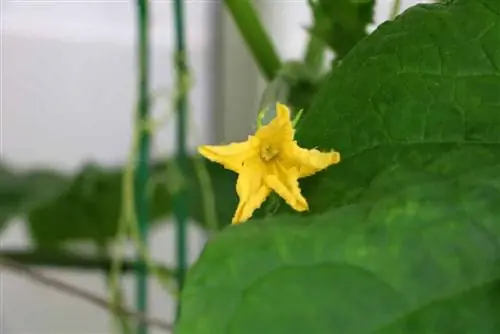
Young cucumber plants in particular are still quite sensitive to cold. That's why they can only be planted late in spring in an unheated greenhouse or even outdoors. The temperatures should be over 12 degrees at night. The planting time therefore does not differ between outdoor planting and planting in an unheated glasshouse. When planted out, the snake cucumbers should already be over 20 cm high. Choose the warmest place in the greenhouse or in the garden for the plants.
- Time: from the end of April in the heated greenhouse
- unheated greenhouse and outdoors: from mid-May
- Planting distance: 50 to 60 cm
- plant only in well-prepared soil
- Mix in 60 g horn shavings and 100 g potassium magnesia per square meter
Cucumbers also like warm temperatures at the root ball. To increase the soil temperature, you can cover the soil with black mulch. So that the irrigation water can penetrate through the film into the soil and at the same time ensure good air circulation, it is important to provide it with slots or holes.
Tip:
It has proven useful to pile up the young plants with soil again after moving them to their final location so that further adventitious roots can form.
Trail support
If the leaves of the cucumber lie on the ground, they will quickly be affected by mold or mildew. And the fruits also rot quickly when they come into contact with moist soil. Vertically placed structural steel mats or other lattice-shaped frames such as wire mesh have proven useful as climbing aids, to which the shoots are guided upwards and possibly tied down. The snake cucumbers slip on smooth plant sticks and break easily, especially if fruit is already hanging on the tendrils.
Balcony
If the snake cucumbers are planted in a bucket of at least 20 liters, they can also be cultivated on the balcony. Make sure that the pot has holes in the bottom so that excess water can drain away. The same conditions apply to care as outdoors.
Care
Cucumbers are not fans of extremes. This applies to both temperatures and water supply. If the plants are exposed to great stress in this regard, the flowers can fall off, the young fruits can die or grow deformed.
Shading
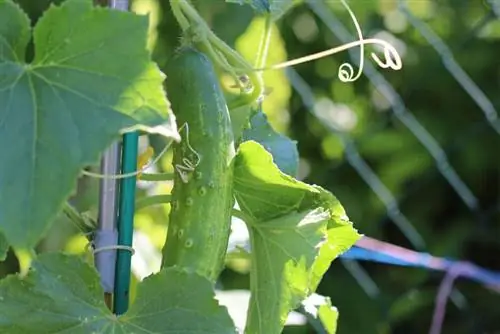
Shading is necessary in the greenhouse on sunny or hot days. To do this, when planting, wires are stretched under the roof to provide internal shading, into which mats or fleece can be inserted. Alternatively, it is of course also possible to place a brushwood mat or fleece on the roof of the greenhouse during midday.
Tip:
In a sunny or partially shaded outdoor location, it is usually not necessary to provide additional shading.
Pouring
Cucumbers require a lot of water, but they cannot tolerate waterlogging. That's why it's best to keep the soil slightly moist and always water a little when the upper substrate layer is already slightly dry. During hot periods, watering twice a day may be necessary. Always water directly onto the root ball and not over the leaves. Only use tempered irrigation water and not cold water from the garden hose. The cucumbers do not tolerate the temperature shock on the roots particularly well.
- water only with preheated water
- for example from the rain barrel
- preferably in the morning and not in the evening
- A layer of mulch prevents excessive evaporation
Humidity in the greenhouse
On the one hand, cucumbers require relatively high humidity, because if the air is dry during the growing season, the fruits are rejected by the plant. On the other hand, the humidity should not rise too much. In this case, there is a risk of dew forming on the leaves when it cools down at night, creating an ideal breeding ground for fungal spores.
Fertilize
Snake cucumbers require relatively high amounts of nutrients for their rapid growth. However, it should be noted that the plants are sensitive to lime and s alt. Therefore, mineral fertilizers are not recommended. Organic fertilizers in the form of compost, horn shavings or slow-release fertilizers for vegetable plants are better for them. For particularly fast-growing varieties, it is advisable not only to fertilize when planting, but also to fertilize once or several times every four weeks with an organic fertilizer in liquid form.
Cutting/Stripping
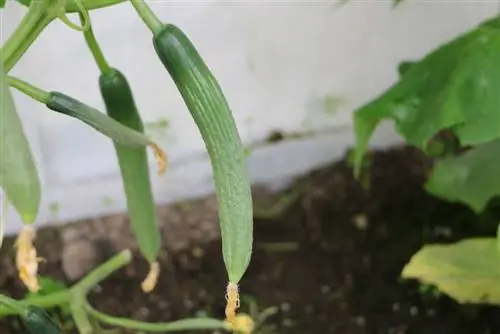
As soon as the cucumber has reached the end of the trellis or the greenhouse roof, the shoot tip is cut off. A maximum of six cucumbers may be left on the main shoot. The lowest cucumber should hang at least 60 cm above the ground.
- remove all side shoots up to a height of 60 cm
- shorten all other side shoots
- Greenhouse: only leave one or two fruit sets per side shoot
- maximum 6 to 8 fruits per plant
- Direct cucumbers in the greenhouse primarily upwards
- For outdoor cucumbers, cut the main shoot after the sixth leaf
- this stimulates the formation of side shoots
- Let side shoots grow a little longer
- cut after the third fruit set
Harvest
Cucumbers ripen very quickly; the first cucumbers can be harvested around two weeks after flowering. If sowing early and cultivating in the greenhouse, this can happen as early as the end of May. Depending on the weather, you usually have to wait until around mid-July for outdoor cucumbers. The taste of the cucumbers is better if they are not quite the size of the cucumbers you get in the supermarket. Cucumbers are harvested by cutting off the stem of the fruit with a knife. Ideally, fresh cucumbers can be harvested twice a week until late summer. At a storage temperature of 13 degrees, the cucumber fruit can be kept for several weeks.
Tip:
Yellow fruits have exceeded the optimal level of ripeness. In order not to weaken the plant excessively, they should be removed immediately.
Proven varieties
When it comes to cucumbers, a distinction is made between outdoor cucumbers and those varieties that can only be grown in a greenhouse. The varieties for greenhouses are generally referred to as cucumbers or cucumbers. Modern greenhouse cucumber varieties form exclusively female plants and therefore do not require pollination to produce fruit. These are so-called virgin-fruited cucumber varieties. Peeled and pickled cucumbers are primarily suitable for outdoor use. There are both classic long cucumbers and short versions. F1 hybrids have proven to be productive. Not only do they have a long harvest period, but they are also resistant to mildew and do not produce bitter substances.
For the greenhouse
- ‘Eiffel’: cucumber up to 35 cm long
- 'Dominica': snake cucumber, up to 35 cm long
- 'Fitness' F1 hybrid: snake cucumber, self-fertile
- ‘Helena’: snake cucumber, self-fertile with long, smooth fruits
- ‘Picolino’ F1 hybrid: mini cucumber
- refined cucumber varieties
Outdoor varieties
- ‘Gergana’: almost smooth-skinned cucumber for outdoor use
- ‘La Diva’: refined house cucumber, suitable for outdoor and greenhouse use
- 'Printo': relatively cold-tolerant, mini snake cucumber, suitable for balconies and containers
- 'Tanja': mixed-flowering country variety
Diseases and pests
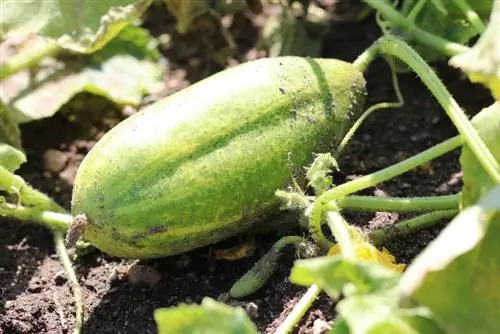
The humidity in the greenhouse should not be too high at night. This usually happens when watering has taken place in the evening and then the temperatures outside drop. In this case, dew forms on the leaves and favors fungal infection. In addition to good ventilation, a resistant or refined variety of cucumber also helps against many diseases. In addition, cucumbers in the greenhouse are often attacked by pests such as aphids, spider mites and thrips. Regular inspection of the undersides of the leaves and leaf axils is therefore essential in order to detect the pests at an early stage. In this case, you can combat them with beneficial insects, adhesive boards or other environmentally friendly measures.
Snails
Outdoor cucumbers often fall victim to snails. Young seedlings in particular are very popular with snails. So be sure to practice good snail prevention so you can expect a bountiful harvest.
Mildew
There are now a large number of varieties resistant to powdery mildew. Downy mildew infestations occur particularly on cool nights and the associated dew formation. Good air exchange is necessary for prevention. If the leaves are too close together and hinder drying, some of them should be removed. Powdery mildew tends to appear after drought in the greenhouse.
Conclusion
Because cucumbers are heat-loving plants, they grow particularly well in a greenhouse. Only robust varieties should be used for outdoor cultivation. Growing cucumbers is incredibly easy if the most important points in care are followed.

